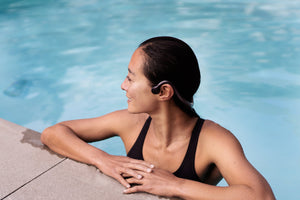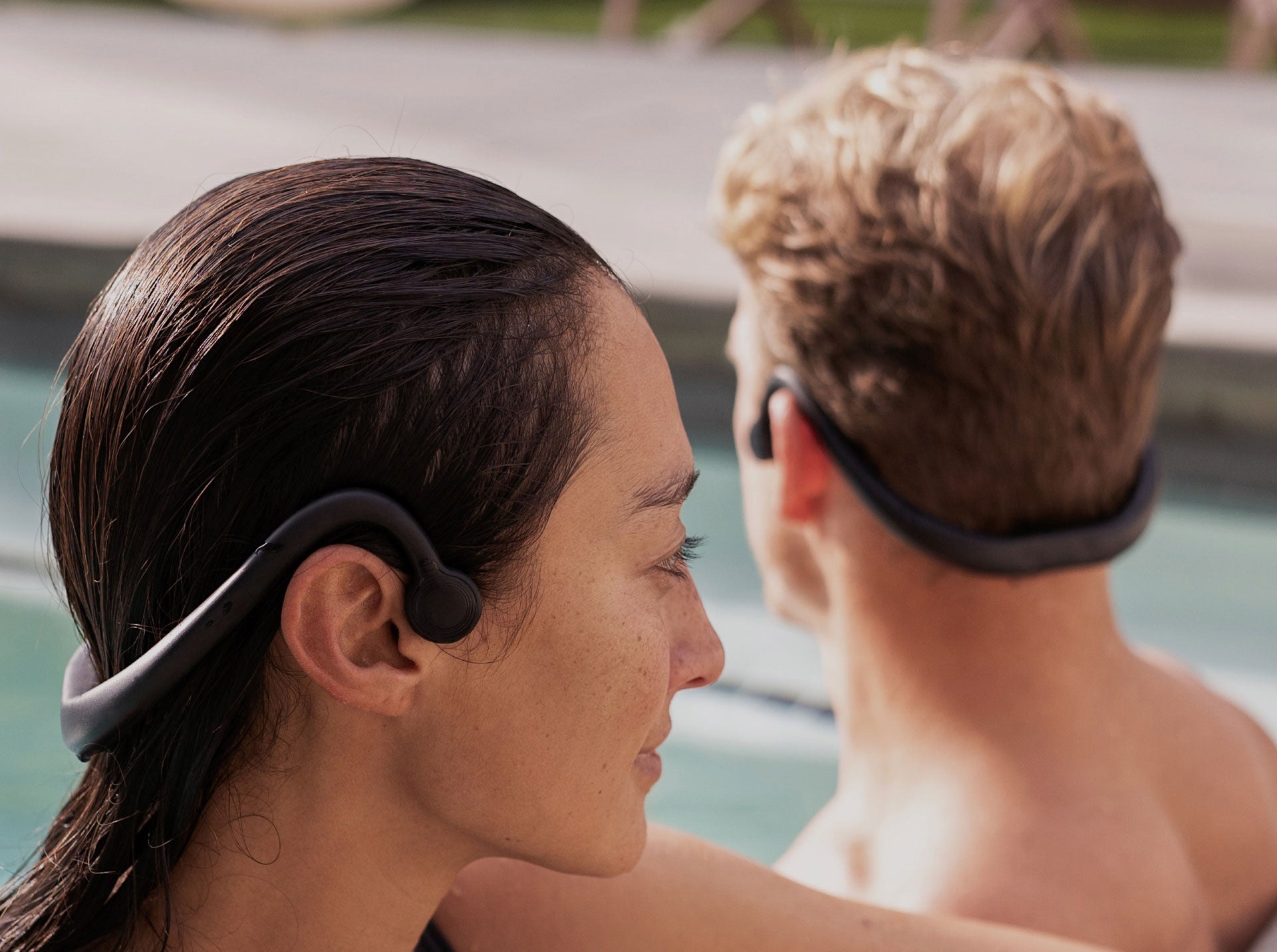How To Listen to Music While Swimming
Do you love listening to music while lifting weights, jogging, or swimming? The former two are easy enough, but when it comes to listening to music underwater, many are left stumped, unsure of their options. Luckily, there are actually options. It’s 2024, and experts have figured out how to listen to your favorite tunes confidently and reliably while swimming.
Whether you’re training for a triathlon, working hard to get in shape, or just swimming for a little relaxation and “you time,” listening to music has many benefits.
Let’s dive right into how listening to music underwater is not only possible but optimal.
Why Do Swimmers Want To Listen to Music Underwater?
People want the option of listening to music underwater for a variety of reasons; most are the same as people who want to listen to music while doing other activities.
The top reported reasons why people desire to listen to music while swimming are:
- It’s Energizing: There are a lot of people who swim first thing in the morning or after work in the afternoon/ evening. Sometimes, a little extra boost of energy from their favorite artist is necessary!
- It Can Be Motivational: If you are indeed training for an event, you may not always be in the mood to train. However, throwing on a song like “Eye of the Tiger” while you bust out those swim strokes can make anyone pumped up.
- Music Can Improve Focus: One thing swimmers need to do in the water is focus. Music can help quiet the outside noise and let the listener focus on their task.
- Music Is a Mood Booster: Music is a fantastic mood booster! The right song can take your day from “blah” to “bravo” in mere minutes.
- Simply Because Music Is Life: Music is the great equalizer. We all love music, and most of us would listen to it all the time if we could. Why should those who choose swimming as their exercise of choice have to miss out?
What Are Some Benefits of Listening to Music While Swimming?
It should come as no surprise that listening to music comes with benefits beyond mere enjoyment. There are actually some scientific benefits that come with listening to music.
Music Can Lessen Anxiety
Did you know that a specific type of therapist is dedicated to music and mental health? It’s true! Music therapists often use music to help reduce stress and anxiety in their patients.
Sometimes, we aren’t quite able to put our anxious feelings into words or even name the feeling at all. Sometimes, music can help build the bridge between our subconscious and conscious minds, and help us realize what we are feeling in the first place.
Specific types of music can also help people shift their emotions. Music therapists will often tell their patients to find a song that matches their current mood to figure out where they are emotionally. Then, they listen to music that embodies where they would like to be emotionally.
Since so many people already use swimming for stress relief, it makes sense that adding some soothing sounds to their workout routine could only improve it. There’s just something so zen about the feeling of your arms crashing into the water and those moments when you’re under the surface, where everything is so still, and it’s just you and the water.
Music Can Improve Your Workout
Believe it or not, listening to music while you work out does more than just stave off boredom — it can actually help improve the quality of your workout! In particular, research shows that listening to upbeat and motivational music or songs synchronized with your exercise is more effective.
A 2010 study discovered that music tends to improve performance in one of two ways: it can delay the onset of fatigue or increase the body’s ability to work hard. Researchers theorize that this is because it distracts the mind from the difficult task at hand and makes us forget about the pain or fatigue we are experiencing.
When you think about it, swimming is the perfect exercise for listening to music. If you’re swimming laps, you want to at least try to keep the same pace from lap to lap.
It’s hard work, so a little distraction from your fatigue would be a welcome guest. Typically, in indoor pools, there is no other music playing, so you have nothing to listen to but the splashing of water and the breathing of other swimmers and yourself.
The Power of BPM on Your Swim Workout
This is true not only for swimming but also for workouts in general. There is a magic number for beats per minute (BPM) that helps you be the most productive in the lap pool.
Many swimmers find that songs with a BPM of 120 to 140 is actually ideal for pace-keeping when it comes to swimming. Considering the fact that music can help with maintaining pace, it’s definitely worth setting up a playlist that is organized by BPM.
You may consider starting out with a slightly slower but still upbeat song for your stretch and warm-up, but then once you get into the main part of your workout, use a song that hits the high end of the recommended BPM, around 140.
Personally, we love cooling down with something slow and steady, with relaxing melodic undertones.
Is It Possible To Use Headphones While Swimming Underwater?
A few years ago, the concept of underwater headphones would have sounded like something straight out of a science fiction TV show, but now? Not so much. Using headphones underwater takes a little finessing but can be just as enjoyable as using the regular headphones you use outside of the water.
There’s only one little problem with trying to use headphones underwater. Even if you have waterproof headphones, Bluetooth technology is not super reliable underwater. Many people have learned this truth the hard way.
Luckily for all of us audiophiles, technology strikes again, and we have discovered workarounds that allow us to use headphones in the pool and have a stellar listening experience while doing it.
How Do Underwater Headphones Work?
Underwater headphones utilize a relatively new type of technology called Bone Conduction. Bone Conduction Technology, or BCT, functions completely differently from conventional headphones.
Whereas regular earbuds or over-ear headphones use vibrations in the air to transmit sound waves, BCT uses vibrations on the skull and jawbones to bypass the ear canal completely. This technology was initially developed for use in hearing aids, but it was quickly discovered to have other uses.
These vibrations stimulate the cochlea directly, and your brain reads it as sound, allowing you to hear music as though it was playing through traditional speakers. If it sounds a little strange, you’re not wrong. It is definitely a different experience at first! However, wearers attest that they quickly get used to it.
Bring in the obstacle of Bluetooth technology. How is it possible to listen to music underwater if Bluetooth doesn’t really work underwater?
Zygo has found the answer with a special transmitter that essentially extends the capabilities of Bluetooth, allowing you to connect your phone directly to the headphones, feed the audio waves through the transmitter, and hear sounds as clear as day.
One amazing benefit of this particular transmitter is that it also functions as a communicator for coaches or other athletes to speak with the swimmer from dry land. It’s a huge game changer, especially in the world of competitive swimming.
What Is the Best Type of Music To Listen to While Swimming?
The type of music you should play in those BCT headphones while swimming depends on your goals.
A Relaxing, Meditative Swim
We recommend soft, flowing, smooth, and atmospheric music if you’re looking for a more serene, destressing swim. Create the audio version of the calm and tranquil atmosphere you are hoping to manifest.
Think chill electronica, acoustic folk, downtempo jazz, lo-fi beats, and orchestral music. You may even want to try nature sounds.
An Energizing Swim
If you’re going for that in-between swim — not quite the super hard workout, but definitely more than a light and easy swim — you’ll want something a little more upbeat. You may be looking for music with a tempo you can swim to. Some styles to try include poppy dance hits, electronic/EDM, high-energy rock, and Latin beats.
A Competitive Swim
Swimming for time? Whether that’s in a competition or training setting, you’re going to want to take your music to the next level.
Consider songs that have a BPM of 140 to 145, and make sure they bring the energy! You know what we’re talking about: motivational rock anthems with a pounding beat, high-tempo indie and indie rock, fast-paced house EDM, and lively funk and soul songs. In general, choose whatever gets you going!
Conclusion
It is truly exciting to live in a time where listening to music underwater while swimming is not only possible but readily available to anyone who wants to partake. The technology is accessible, easy to use, and effective. Bone conduction technology has come a long way, and we are excited to see how far it will go.
With its energizing, mood-boosting, and even performance-boosting effects, there’s no question that blasting your favorite playlist for your next swim is well worth it. If you haven’t given underwater BCT headphones, definitely give them a chance. Happy swimming!
Sources:
Bone Conduction - An Overview | ScienceDirect Topics
Music Can Serve as Therapy. Here's How it Can Help Reduce Anxiety | The Washington Post
Can Listening to Music Improve Your Workout? | National Center for Health Research



